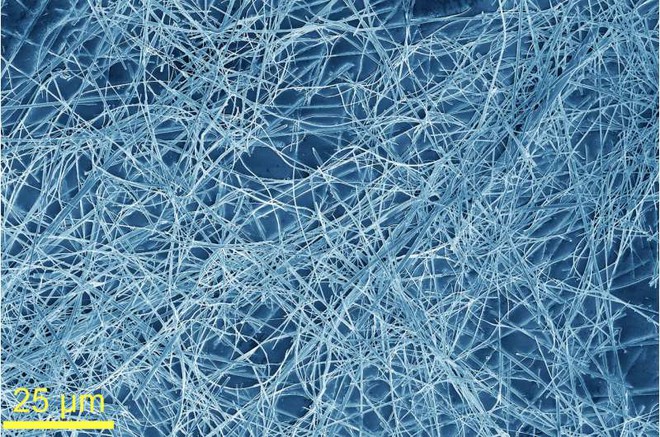Paint the wall with this 1-D material that will help you “lock” the wifi in your house, not allow you to escape to the neighbor’s house.
- Tram Ho
When electronic devices saturate every corner of life, there was a problem: It was the interference of electromagnetic fields emitted by different devices that could interfere with each other. In engineering, the scientists call this phenomenon electromagnetic interference (EMI).
For example, Wi-Fi waves emitted from a neighbor’s modem can interfere with your Wi-Fi signal. Bluetooth waves or even a blender in the kitchen can interfere with the TV next to the living room. Electromagnetic interference is also the reason airlines always have to ask passengers to turn off their phones or turn on ” Airplane Mode ” every time they take off and land.

To solve this problem, engineers have long sought for a lightweight, mechanically stable, flexible and easy to manufacture material that could ” trap ” electromagnetic waves in confined spaces.
On the one hand, it can effectively minimize electromagnetic interference operation. On the other hand, it can make your connections more secure, even protect your health with concerns about the effects of electromagnetic waves on your body.
And as you can imagine, if there is a material that blocks electromagnetic waves, you can use it to blend into your paint or wall stickers to limit the range of personal Wi-Fi access. No longer will the neighbors be able to “hack” or catch your Wifi pagoda. Isn’t that great?
The magic comes from 1D (1 dimensional) material.
All of this is no longer a fictional future, after a team of engineers at the University of California claimed to have created a flexible film, using a one-way, highly productive, nano-filler. and, more importantly, is absolutely capable of blocking electromagnetic waves.
Their research has just been published in the leading journal in the field of materials science Advanced Materials. Alexander A. Balandin, eminent professor of electromagnetic and computer engineering at Marlan Technical University, said one of the study co-authors:
“These novel films promise applications in high-frequency communications technologies that require flexible, lightweight, corrosion-resistant, inexpensive and insulating screens. robust to high frequency radio frequency radiation while remaining insulated from direct current measurements.
To create this new material, Prof Balandin’s team used TaSe3, a material close to 1D. Simple understanding of 1D or one-dimensional materials, that is, an atom or their molecule can be linked at least with only one molecule, atoms next to it.

Materials that we normally use are all in 3D, meaning that one atom of them is at least bonded with three atoms next to it. 2D materials like graphene thin films are materials where one atom can at least be bonded with two atoms next to it.
If you use maximum magnification electron microscopes on these materials, you will see that 3D materials are always solid, 2D materials are flat and 1D materials are filaments, with only one fiber. unique atoms or molecules linked together in chains by van der Waals attraction.
Since van der Waals is a weak attraction, it is difficult to fabricate an ideal 1D material. As a result, scientists are currently only progressing to fabricating materials close to 1D. That success is measured by a parameter called the “aspect ratio ” which is the length divided by the width of the material fiber. The larger the “Aspect ratio” , the closer the material gets to 1D.
For the TaSe3 nanofibers in this study, Professor Balandin and his colleagues brought the aspect ratio to a threshold of 10 ^ 6. At this threshold close to this 1D material, the free electrons in the TaSe3 fiber will interact with the electric field wave allowing it to absorb or completely reflect the electromagnetic energy.
Non-conductive and provides a shielding effect of up to 99.99%
However, the most interesting point here is that TaSe3 is inherently a metal that Professor Balandin can make it non-conductive. The way to do this is to fill the TaSe3 fibers into the polymer. Because the fibers are very difficult to contact each other at the nanoscale, electricity cannot flow through the material, and the material becomes even lighter.

Fiber materials TaSe3 1D in the study of Professor Balandin et al.
That is what scientists have been looking for for so long. We know if we want to block electromagnetic waves in a room then simply build it with metal walls. Metal can also block electromagnetic waves, so your aluminum-framed phone must always have plastic strips for the waves to run in and out.
But the downside to metals is that they are heavy, conductive, and expensive. You can’t build electromagnetically powered interceptors that have a conductive metal shell. You also cannot cover the ceiling and wrap the steel walls around your house just to prevent neighbors from catching the Wifi pagoda.
With TaSe3 threads nowadays, work will be a lot easier. You can mix them in paint or wallpaper glue, then apply a film. ” The shielding effect can be as high as 99.99% with just a membrane a few micrometres thick and it does not conduct electricity at all, ” said Zahra Barani, a graduate student involved in the study.

Of course, scientists do not invest money just to help you secure your Wi-Fi. Professor Balandin said the TaSe3 material he created has many other important applications. Its ultimate purpose is to minimize EMI electromagnetic interference.
As electronic devices get smaller and larger, we will need a new generation of shielding materials and the TaSe3 will fully meet the criteria for use in the next generation of electronics in the future. hybrid.
Synthetic materials that have demonstrated excellent electrical insulation and EMI shielding are particularly effective in the gigahertz and sub-terahertz bands, the frequency range where current and future communications technologies will focus on cascade used.
Refer to Phys, Nanowerk, S iencedirect
Source : Genk
